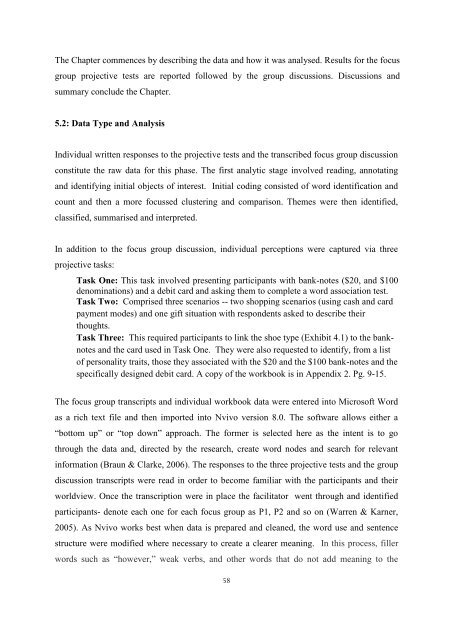Cash or Card: Consumer Perceptions of Payment Modes - Scholarly ...
Cash or Card: Consumer Perceptions of Payment Modes - Scholarly ...
Cash or Card: Consumer Perceptions of Payment Modes - Scholarly ...
Create successful ePaper yourself
Turn your PDF publications into a flip-book with our unique Google optimized e-Paper software.
The Chapter commences by describing the data and how it was analysed. Results f<strong>or</strong> the focus<br />
group projective tests are rep<strong>or</strong>ted followed by the group discussions. Discussions and<br />
summary conclude the Chapter.<br />
5.2: Data Type and Analysis<br />
Individual written responses to the projective tests and the transcribed focus group discussion<br />
constitute the raw data f<strong>or</strong> this phase. The first analytic stage involved reading, annotating<br />
and identifying initial objects <strong>of</strong> interest. Initial coding consisted <strong>of</strong> w<strong>or</strong>d identification and<br />
count and then a m<strong>or</strong>e focussed clustering and comparison. Themes were then identified,<br />
classified, summarised and interpreted.<br />
In addition to the focus group discussion, individual perceptions were captured via three<br />
projective tasks:<br />
Task One: This task involved presenting participants with bank-notes ($20, and $100<br />
denominations) and a debit card and asking them to complete a w<strong>or</strong>d association test.<br />
Task Two: Comprised three scenarios -- two shopping scenarios (using cash and card<br />
payment modes) and one gift situation with respondents asked to describe their<br />
thoughts.<br />
Task Three: This required participants to link the shoe type (Exhibit 4.1) to the bank-<br />
notes and the card used in Task One. They were also requested to identify, from a list<br />
<strong>of</strong> personality traits, those they associated with the $20 and the $100 bank-notes and the<br />
specifically designed debit card. A copy <strong>of</strong> the w<strong>or</strong>kbook is in Appendix 2. Pg. 9-15.<br />
The focus group transcripts and individual w<strong>or</strong>kbook data were entered into Micros<strong>of</strong>t W<strong>or</strong>d<br />
as a rich text file and then imp<strong>or</strong>ted into Nvivo version 8.0. The s<strong>of</strong>tware allows either a<br />
“bottom up” <strong>or</strong> “top down” approach. The f<strong>or</strong>mer is selected here as the intent is to go<br />
through the data and, directed by the research, create w<strong>or</strong>d nodes and search f<strong>or</strong> relevant<br />
inf<strong>or</strong>mation (Braun & Clarke, 2006). The responses to the three projective tests and the group<br />
discussion transcripts were read in <strong>or</strong>der to become familiar with the participants and their<br />
w<strong>or</strong>ldview. Once the transcription were in place the facilitat<strong>or</strong> went through and identified<br />
participants- denote each one f<strong>or</strong> each focus group as P1, P2 and so on (Warren & Karner,<br />
2005). As Nvivo w<strong>or</strong>ks best when data is prepared and cleaned, the w<strong>or</strong>d use and sentence<br />
structure were modified where necessary to create a clearer meaning. In this process, filler<br />
w<strong>or</strong>ds such as “however,” weak verbs, and other w<strong>or</strong>ds that do not add meaning to the<br />
58

















